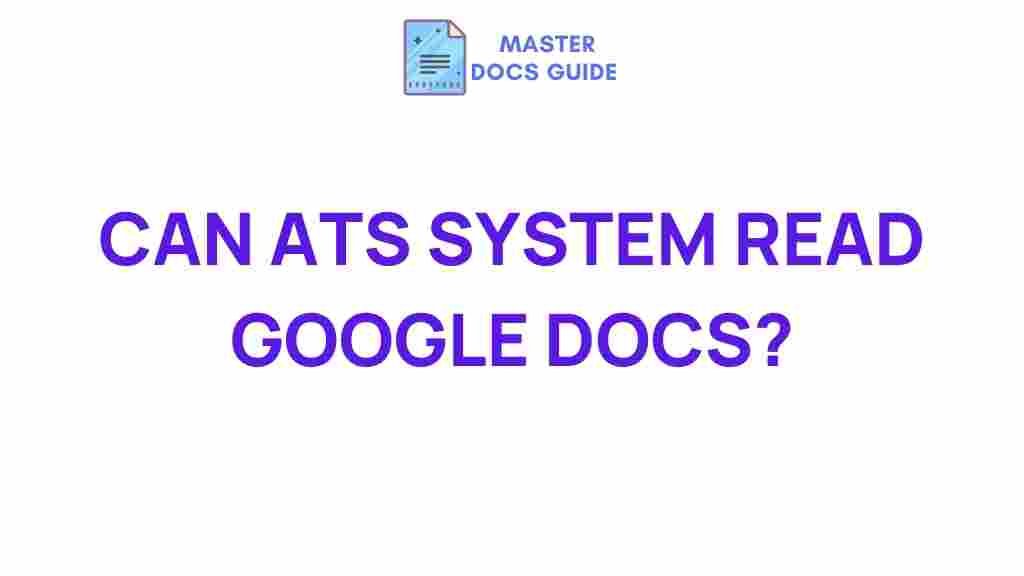Unveiling the Mystery: Can ATS Systems Decode Google Docs?
In the digital age, job seekers are increasingly turning to technology to enhance their chances of landing a desired position. One common question that arises is whether ATS systems can effectively decode Google Docs. Understanding the compatibility between ATS systems and Google Docs is crucial for candidates looking to optimize their resumes for recruitment software. This article delves into the intricacies of ATS systems, the nuances of Google Docs, and the best practices for ensuring your resume is scanned successfully.
What is an ATS System?
An ATS system, or Applicant Tracking System, is a type of recruitment software that automates the hiring process for employers. These systems help organizations manage job applications, streamline the recruitment process, and ensure that the right candidates are identified efficiently. ATS systems scan resumes for keywords, formatting, and other criteria to determine if a candidate fits the job description.
The Importance of Resume Compatibility
When submitting a resume, it’s essential to consider the format in which it is sent. Many employers use ATS systems to filter out unqualified candidates before human eyes ever see the application. Therefore, the compatibility of your resume with the ATS is paramount. If your resume is not in a compatible format, it may be misread or entirely ignored.
Understanding Google Docs and ATS Compatibility
Google Docs has become a popular tool for creating and editing documents, including resumes. However, the question remains: can ATS systems effectively read Google Docs? Let’s explore this further.
Google Docs: The Basics
Google Docs is a web-based word processor that allows users to create, edit, and share documents online. Its versatility and ease of use make it a preferred choice for many job seekers. However, the default format of a Google Doc is not always ATS-friendly.
ATS System Compatibility with Google Docs
While some ATS systems can read Google Docs, the results are not always guaranteed. Here are some key considerations:
- File Format: ATS systems typically favor file formats like .docx or .pdf. While you can export a Google Doc to these formats, a direct upload of a Google Doc may lead to formatting issues.
- Formatting: Complex formatting, such as tables, images, and unusual fonts, can confuse ATS systems. Simple, clean formatting is essential for compatibility.
- Content Structure: ATS systems scan for specific keywords and phrases. Ensure that your resume is structured in a way that allows these keywords to be easily identified.
How to Ensure ATS Compatibility When Using Google Docs
To maximize the odds that your resume will be accurately read by an ATS system, follow these steps:
Step 1: Use Simple Formatting
When creating your resume in Google Docs, opt for a straightforward layout. Avoid using templates that have elaborate designs. Stick to the following:
- Standard fonts like Arial, Calibri, or Times New Roman.
- A font size of 10-12 points for body text.
- Consistent heading styles for sections like “Experience,” “Education,” and “Skills.
Step 2: Export to a Compatible Format
Once your resume is complete, it’s essential to export it to a format that ATS systems can easily read. Follow these steps:
- Click on “File” in Google Docs.
- Select “Download.”
- Choose “Microsoft Word (.docx)” or “PDF Document (.pdf)” as the format.
Both formats are widely accepted by ATS systems, but .docx is often preferred for its compatibility.
Step 3: Optimize for Keywords
Research the job description and make sure to include relevant keywords throughout your resume. This may include:
- Job titles.
- Skills and qualifications.
- Industry-specific terminology.
Incorporating these keywords naturally into your resume will help ATS systems identify your suitability for the position.
Step 4: Use Plain Text for Important Information
When exporting your resume, ensure that critical information is accessible and easily readable. Avoid embedding text in images or using text boxes. Keep your content in the main body of the document.
Troubleshooting Common Issues with Google Docs and ATS
Even after following the best practices, issues may still arise when using Google Docs with ATS systems. Here are some common problems and solutions:
Problem 1: Formatting Errors
If your resume looks good in Google Docs but appears jumbled when uploaded to an ATS, consider these solutions:
- Export the document as a .docx file and check the formatting in Microsoft Word.
- Remove any special characters or unusual fonts that ATS may not recognize.
Problem 2: Missing Information
If important sections of your resume are missing after uploading, ensure that:
- Your headings are clearly labeled (e.g., “Experience,” “Education”).
- You avoid using headers or footers for critical information.
Problem 3: No Keywords Detected
To avoid ATS systems missing your keywords, consider the following:
- Use variations of keywords found in the job description.
- Incorporate keywords into bullet points and descriptions, not just in the skills section.
Conclusion
As job seekers turn to technology to enhance their applications, understanding the compatibility of ATS systems with Google Docs is crucial. While Google Docs can be a convenient tool for creating resumes, it’s essential to ensure that the final product is ATS-friendly.
By following the steps outlined in this article—using simple formatting, exporting to compatible file types, optimizing for keywords, and troubleshooting common issues—you can significantly enhance your chances of passing the initial resume scanning process.
For more tips on optimizing your resume and navigating the recruitment process, check out our comprehensive guide. Don’t forget to stay updated on the latest trends in recruitment technology by visiting industry resources.
In the competitive job market, make sure your application stands out and is easily readable by ATS systems, ensuring you don’t miss out on your dream job opportunity.
This article is in the category Tech News and created by MasterDocs Guide
